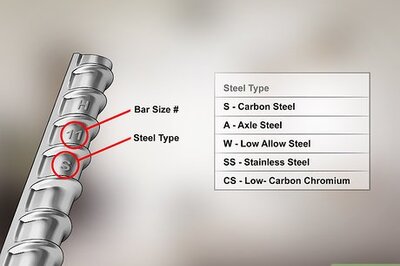
views
How to Replace the Cabin Air Filter in Your Car
Check your vehicle’s manual for the air filter’s location. On most vehicles, the the cabin air filter is located behind the glove box or a piece of trim on the passenger side of your vehicle. Some vehicles may have access from underneath the hood. Because it varies between every make and model, be sure to check the manual to make sure you’re working in the right area. If you don’t have a manual, auto detailing expert Chad Zani recommends going online and searching for your make and model with the words “cabin filter” to learn where the filter is located.
Remove the glove box or trim pieces, if needed. If you have to take out your glove box, open and empty it first. On most models, first disconnect the lever holding the glove box in place. Then, locate the tabs or screws inside the glove box and undo them. Your glove box will easily lift out so you have access behind it. If you have to remove a trim piece, look for small tabs or clips holding it in place and gently pry it off. On some newer vehicles, the cabin filter may be accessible without removing your glove box. You usually don’t need any special tools to remove a glove box or change a cabin filter, but keep a screwdriver on hand just in case.
Pull the old filter out and throw it away. Look for a rectangular panel cover and undo the clips to expose the old filter. Wear a pair of disposable gloves, and simply pull the dirty filter straight out from the compartment. Toss the filter into your regular trash can. Some large or luxury vehicles have 2 cabin air filters. Once you remove the first one, the second one will be accessible. Cabin filters are usually covered with dirt, dust, and small road debris, so be careful not to spill or drop it inside your vehicle.
Slide the new air filter into your vehicle. Purchase a cabin air filter that’s made for the make and model of your vehicle. Look for the text or arrow on the side of the filter and make sure it’s facing up. Then, simply slide the filter into the slot and replace the panel cover. Try to use a HEPA-approved filter to catch the most contaminants and allergens before they get inside your vehicle.
Reinstall the glove box or trim you had to remove. Pop the trim pieces back into place and make sure they’re firmly seated onto your vehicle. If you removed the glove box, slide it back into position and redo the fasteners that held it in place. After it’s reattached, you’re finished replacing your filter.
How Often to Replace the Cabin Air Filter
Change your air filter every 15,000 mi (24,000 km) or once a year. Keep track of your vehicle’s mileage when you replace the cabin air filter so you know when it’s time to replace it. While it may vary on how frequently you drive, checking and replacing the filter annually will help keep your vehicle’s HVAC system running properly. Check your vehicle’s manual for a more specific replacement schedule for your make and model.
Signs of a Bad Cabin Air Filter
Musty AC odors Zani mentions that when your filter is full of dirt or leaves that start rotting, the filter can store foul smells. If you notice a foul odor any time you run the AC or heat in your vehicle, an old filter may be to blame.
Poor vent airflow If your cabin air filter is clogged with debris, then it limits the amount of air that moves through your vents. When you notice that you’re not getting a lot of power from your AC even when you crank up the fan, then check the filter.
Slower window defrosting or defogging Because a clogged filter restricts airflow, your defroster may not melt ice or clear fog on your windshield as quickly. If you’re waiting a long time for your windows to clear up before driving, the cabin air filter could be the culprit.
More dust inside your vehicle When the cabin air filter gets old or clogged, finer particles can find their way through your vents and into your vehicle. If you’ve noticed a lot more dust building up on the surfaces or if you’re sneezing more often while driving, there’s a good chance it’s time to replace your filter.
FAQ
What does a cabin air filter do? The cabin air filter in your vehicle catches dust, allergens, and other road debris before it moves through the AC vents in your vehicle. It also helps trap foul odors before they get inside your vehicle. With the filter, only clean filtered air will enter your vehicle so your interior stays clean and smelling fresh.
What happens if I don’t replace a cabin air filter? If you leave a dirty cabin air filter installed, it could restrict the airflow in your vehicle and put more pressure on your HVAC system. Because an old filter can also let in more dust and allergens, an old filter can also make your vehicle dirtier or make you feel stuffy and sneezy.
What’s the difference between engine and cabin air filters? The engine air filter prevents dust and debris from entering your engine’s combustion chamber. This helps fuel burn clean and efficiently so your engine runs properly without getting damaged. The cabin air filter only connects to your vehicle’s ventilation system and prevents contaminants from getting inside your vehicle. You may also clean and replace your engine air filter if it’s really dirty or damaged.
















Comments
0 comment